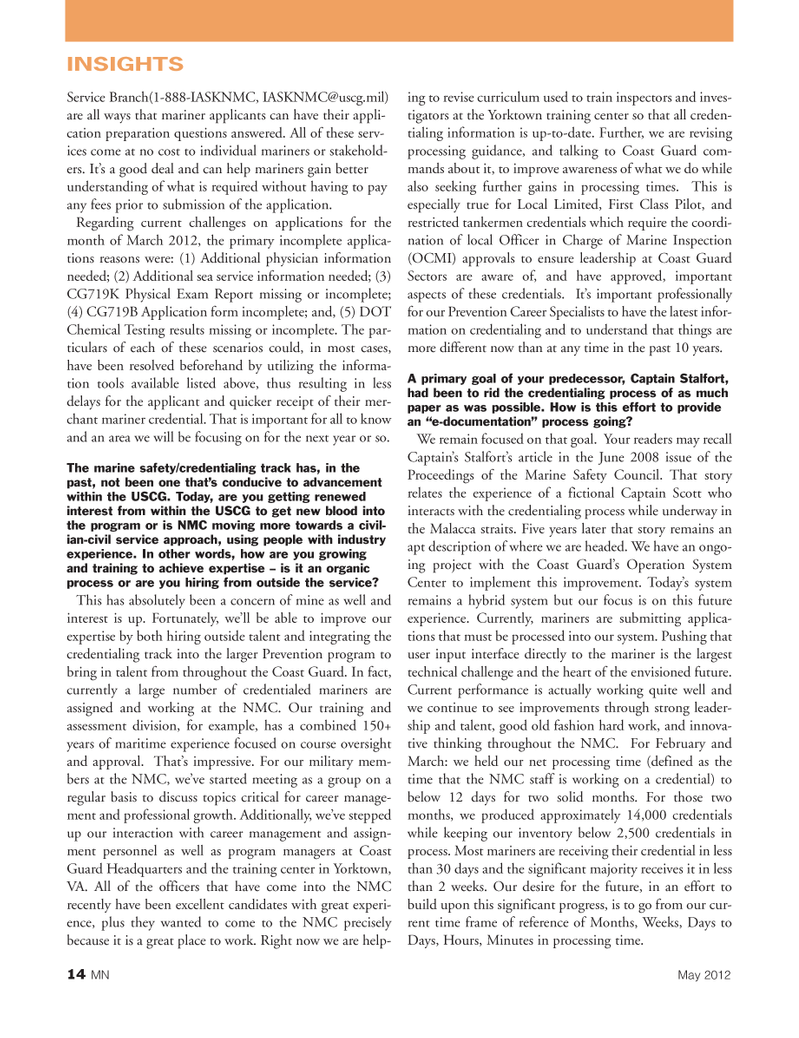
Page 14: of Marine News Magazine (May 2012)
Combat Craft Annual
Read this page in Pdf, Flash or Html5 edition of May 2012 Marine News Magazine
14MNMay 2012Service Branch(1-888-IASKNMC, [email protected]) are all ways that mariner applicants can have their appli- cation preparation questions answered. All of these serv- ices come at no cost to individual mariners or stakehold-ers. It?s a good deal and can help mariners gain better understanding of what is required without having to pay any fees prior to submission of the application. Regarding current challenges on applications for the month of March 2012, the primary incomplete applica- tions reasons were: (1) Additional physician information needed; (2) Additional sea service information needed; (3) CG719K Physical Exam Report missing or incomplete; (4) CG719B Application form incomplete; and, (5) DOT Chemical Testing results missing or incomplete. The par- ticulars of each of these scenarios could, in most cases,have been resolved beforehand by utilizing the informa- tion tools available listed above, thus resulting in less delays for the applicant and quicker receipt of their mer- chant mariner credential. Tha t is important for all to know and an area we will be focusing on for the next year or so. The marine safety/credentialing track has, in the past, not been one that?s conducive to advancement within the USCG. Today, are you getting renewed interest from within the USCG to get new blood into the program or is NMC moving more towards a civil- ian-civil service approach, using people with industry experience. In other words, how are you growing and training to achieve expertise ? is it an organic process or are you hiring from outside the service? This has absolutely been a concern of mine as well and interest is up. Fortunately, we?ll be able to improve our expertise by both hiring outside talent and integrating the credentialing track into the larger Prevention program to bring in talent from throughout the Coast Guard. In fact, currently a large number of credentialed mariners are assigned and working at the NMC. Our training and assessment division, for example, has a combined 150+years of maritime experience focused on course oversight and approval. That?s impressive. For our military mem- bers at the NMC, we?ve started meeting as a group on a regular basis to discuss topics critical for career manage- ment and professional growth. Additionally, we?ve stepped up our interaction with career management and assign- ment personnel as well as program managers at Coast Guard Headquarters and the training center in Yorktown, VA. All of the officers that have come into the NMC recently have been excellent candidates with great experi- ence, plus they wanted to come to the NMC precisely because it is a great place to work. Right now we are help- ing to revise curriculum used to train inspectors and inves- tigators at the Yorktown training center so that all creden- tialing information is up-to-date. Further, we are revising processing guidance, and talking to Coast Guard com- mands about it, to improve awareness of what we do while also seeking further gains in processing times. This is especially true for Local Limited, First Class Pilot, and restricted tankermen credentials which require the coordi- nation of local Officer in Charge of Marine Inspection (OCMI) approvals to ensure leadership at Coast Guard Sectors are aware of, and have approved, important aspects of these credentials. It?s important profession allyfor our Prevention Career Specialists to have the latest infor- mation on credentialing and to understand that things are more different now than at any time in the past 10 years. A primary goal of your predecessor, Captain Stalfort, had been to rid the credentialing process of as much paper as was possible. How is this effort to provide an ?e-documentation? process going? We remain focused on that goal. Your readers may recall Captain?s Stalfort?s article in the June 2008 issue of the Proceedings of the Marine Safety Council. That story relates the experience of a fictional Captain Scott who interacts with the credentialing process while underway in the Malacca straits. Five years later that story remains an apt description of where we are headed. We have an ongo- ing project with the Coast Guard?s Operation System Center to implement this improvement. Today?s system remains a hybrid system but our focus is on this future experience. Currently, mariners are submitting applica- tions that must be processed into our system. Pushing that user input interface directly to the mariner is the largest technical challenge and the heart of the envisioned future. Current performance is actually working quite well and we continue to see improvements through strong leader- ship and talent, good old fashion hard work, and innova- tive thinking throughout the NMC. For February and March: we held our net processing time (defined as the time that the NMC staff is working on a credential) to below 12 days for two solid months. For those two months, we produced approximately 14,000 credentials while keeping our inventory below 2,500 credentials in process. Most mariners are receiving their credential in less than 30 days and the significant majority receives it in less than 2 weeks. Our desire for the future, in an effort to build upon this significant progress, is to go from our cur- rent time frame of reference of Months, Weeks, Days to Days, Hours, Minutes in processing time. INSIGHTSMN#5 (1-17):MN 2011 Layouts 5/7/2012 1:05 PM Page 14

 13
13

 15
15
